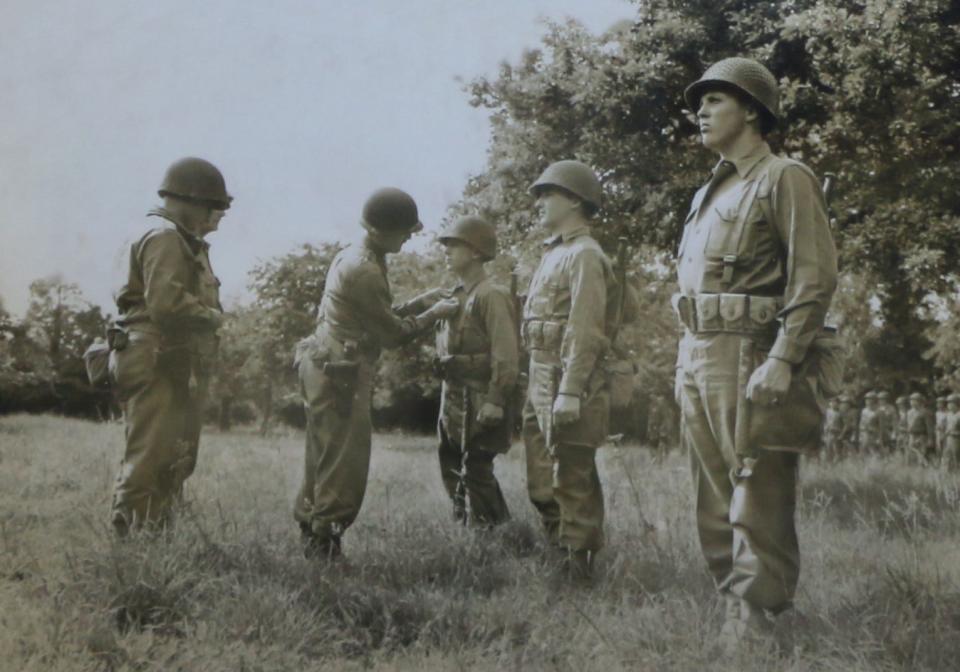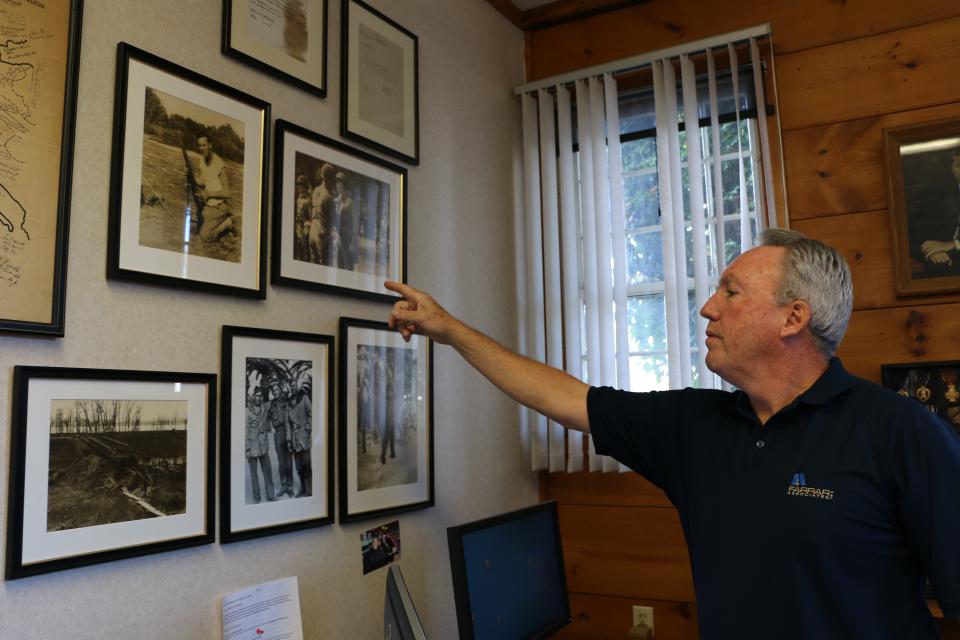On the front lines during WWII, Newport solider's story will be told to future generations
NEWPORT — Army Sgt. William Farrar landed with his engineer combat battalion on Omaha Beach on D-Day — June 6, 1944 — at the beginning of the largest seaborne invasion in history that left about 4,500 Allied soldiers confirmed dead.
After spending the first night shivering in shallow foxholes in a small draw 200 yards from the water’s edge, Farrar and his comrades were assigned to removing obstacles and mines from the beach, then keeping the nearby roads open for the march inland.
Just three days after landing, Farrar’s 1340th Engineer Combat Battalion came to the Aure River, where a major obstacle was blocking the road, according to the unit’s official history. German troops were protecting the obstacle with accurate and steady small arms fire.
More: Local veterans organizations lend a hand with tarnished grave at Middletown cemetery
“Three volunteers rode up to the obstacle on a Sherman tank, planted a charge, jumped back onto the tank, and rode away as the road block was blown clear,” says the history, simply called the “1340th Engineer Combat Battalion.”

One of those volunteers who rode to the obstacle on the back of the tank was Farrar.
How the story of William Farrar will live on
His son, James Farrar, principal of Farrar & Associates and a major contractor in Newport, was contacted earlier this year by John Vance, an education and exhibit specialist for the United States Army Engineer Museum in Fort Leonard Wood, Missouri.
“I am writing a vignette about the mission that your father went on,” Vance wrote in an email. “I plan to use it during classes with new engineer soldiers to reinforce Army values. Your father is definitely one of the Engineer corps heroes.”
More: Newport Naval Station welcomed the first Navy ship in two years — the USS Daniel Inouye
The night of June 9, right after soldiers Farrar, Leo Bradford and Michael Szelwach blew up the road obstacle, they and other combat engineers moved to the river and, under fire, constructed a 50-foot-long Bailey Bridge. This type of portable, pre-fabricated, truss bridge was developed in 1940-1941 by the British and saw extensive use by U.S. military engineering units. The bridges were strong enough to carry tanks.
“This marked the building of the first bridge” of the Allied campaign to invade Germany from the Normandy beaches of France, according to the unit’s history.
“I love how they write about it like it’s just another day at work, no big deal," Vance wrote. "I can’t imagine hearing: 'I need volunteers to ride on the back of this tank with TNT, drive head on into the enemy position, and jump off and blow up the obstacle!' It’s amazing the courage that your father had!”
The three men who volunteered to undertake the dangerous mission each received the Silver Star, which is awarded for singular acts of valor or heroism. Jim Farrar said his father also received the Croix de Guerre from the French government.
More: Military veterans were told to move out of Aquidneck Island housing. This is why.
In histories of World War II, the crossing of the Aure River is noted as an initial milestone as U.S. infantry units advanced with the goal of first liberating France from German occupation, then continuing into Germany to end Adolf Hitler’s regime.
'It was one of the worst battles for the Army'
Jim Farrar was reading a book about the landing on D-Day and the battle campaign in Normandy when he came across a chapter titled “June 9” that recounted the building of the bridge.
“It was a pivotal moment in the campaign,” he said. “It has been documented in so many sources.”
The 38th Combat Team moved across the river the next morning after construction of the bridge to take control of Trevières.
One private in the 38th Infantry regiment, James Branch, wrote about his experiences after crossing the Aure River in an online blog called “Men of D-Day.
More: 'Good reminder of the sacrifices': Boots on the Ground display honors fallen soldiers
“We encountered stiff resistance around Trevières — we were attacking without our heavy weapons, as they were to come ashore yet,” wrote Branch, who also had landed on Omaha Beach on June 6. “After house-to-house battling in Trevières we then moved to take Cerisy. We captured a road junction near Haute Littee cutting the Saint Lô Bayeux highway, then one our companies took the village of Vaucrevon. On our first two days in combat we advanced a total of 17 Kilometres. Not bad for a first-time-in-combat infantry regiment without its heavy weapons.”
Farrar and the others in the 1340th Engineer Combat Battalion stayed with the combat infantry as it advanced into Germany’s Hurtgen Forest. Farrar was lucky to survive these battles.
“Here a separate chapter in the history of this organization was written in blood and agony,” the unit’s history says. “The division met with extremely heavy opposition in the attack and the 1340th moved up to keep the route open for supplies to get through. To keep this route open meant to take hold of a bridge in this vicinity and to protect the flanks of the route. In this vital and exposed position with no supporting weapons, the 1340th held firm against murderous and unrelenting artillery and mortar fire. It repulsed numerous small counterattacks and infiltrating patrols. It watched its supply trains, needed desperately, be shattered by deadly mortar fire and it endured with grossly inadequate protection the merciless fury of winter at its worst. After four days, when the infantry troops were withdrawn across the river, the 1340th had completed its four-day mission in hell.”

The battalion had suffered 75% casualties among those committed to action and had lost much equipment. With one day’s rest, though, the soldiers went back to maintaining roads in the Hurtgen Forest.
“It was one of the worst battles for the Army,” Jim Farrar said.
More: Vietnam Veterans Memorial Wall serving region dedicated in Fall River
William Farrar was with the combat engineers in the North Africa campaign, as well as the invasion of Sicily. They stayed together as they went into France and Germany, right up to April 1945, when they accompanied armored units as they sped toward Leipzig, Germany, building bridges and clearing roads.
On April 27, they constructed a Bailey Bridge over the Mulde River near Eilenburg, replacing a lighter bridge used by the 69th Infantry Division to link up to Russian forces at Torgau.
On May 8, 1945 the battalion received the news of the unconditional surrender of Germany.
During his 3½ years of service, William Farrar had seen non-stop combat in French Morocco, Algeria, Sicily, Normandy, the Ardennes Forest that extends from Belgium into Germany, and then across Germany, before pulling back into Czechoslovakia at the end of the war.
“My father was extremely lucky to have survived all of that, but he didn’t really talk about it,” Jim Farrar said. “We always knew he was at the front. Talking to other veterans who served in World War II, I was often told, “Not many of us saw the front line action your father saw.”
More: On scaled-back Veterans Day, organizations like VFW, Legion struggle to find new members
Besides his Silver Star, the U.S. military awarded William Farrar two Purple Hearts for the shrapnel wounds he received in combat; eight Battle Stars; the European-African-Middle Eastern Theater Ribbon with Bronze Arrowhead; and a Good Conduct Medal.
War hero returns to Newport and raises a family
When Farrar returned to the United States after the war, he married Mary A. Sullivan, who had deep roots in Newport, and they had two sons, Jim and William. William Farrar Sr. worked first in sales and then had a civilian administrative job at the former Naval Underwater Systems Center (NUSC), now the Naval Undersea Warfare Center (NUWC). He died in 1973 at the age of 53.
“He was a tough guy — you don’t go through what he did without being tough,” Jim Farrar said. “He didn’t take care of himself though. It was a different era.”
Jim Farrar earned degrees in civil and construction engineering after his father's death. Was he influenced by the fact his father, while not a trained engineer, was a combat engineer?
“Maybe, but my whole family history, from my grandfather to my uncles, they were all developers and contractors," he said. "There was that, as well as my father’s work in the field. There’s a little bit of it in the blood. I decided to go to school for it and study it.”
He is gratified by the attention his father’s combat service and heroics are receiving at the Army Engineer Museum.
More attention than ever seems focused on the contributions of the World War II “greatest generation” since the 75th anniversary of the war’s ending in 2020 and now continuing on, Farrar said.
“It is really important to us here at the museum to save the stories of our heroes before they are lost to time,” Vance said.
This article originally appeared on Newport Daily News: Late Newport veteran William Farrar honored for World War II heroics

